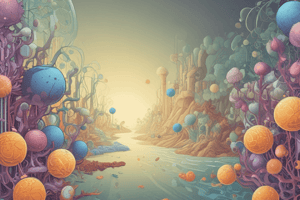Podcast
Questions and Answers
What type of microorganisms are usually found in water?
What type of microorganisms are usually found in water?
- Bacteria
- Fungi
- Protozoa (correct)
- Viruses
Which organisms require host cells to reproduce?
Which organisms require host cells to reproduce?
- Viruses (correct)
- Fungi
- Bacteria
- Protozoa
Which group of microorganisms can be found in habitats ranging from glaciers to deserts and hot water bodies?
Which group of microorganisms can be found in habitats ranging from glaciers to deserts and hot water bodies?
- Bacteria (correct)
- Algae
- Fungi
- Protozoa
Which viruses are examples given in the text?
Which viruses are examples given in the text?
Which microorganisms are known for carrying out photosynthesis?
Which microorganisms are known for carrying out photosynthesis?
Where can microorganisms survive?
Where can microorganisms survive?
Which of the following is an example of a fungus?
Which of the following is an example of a fungus?
Which of the following is true about protozoa?
Which of the following is true about protozoa?
What characteristic describes Fungi?
What characteristic describes Fungi?
Which useful bacterium is mentioned as being good for the human body?
Which useful bacterium is mentioned as being good for the human body?
Which microorganism is responsible for the conversion of milk into curd?
Which microorganism is responsible for the conversion of milk into curd?
What is the role of yeast in the food industry?
What is the role of yeast in the food industry?
Which acid is produced by yeast in the beverage industry?
Which acid is produced by yeast in the beverage industry?
When did Louis Pasteur discover the process of fermentation?
When did Louis Pasteur discover the process of fermentation?
From which organisms are antibiotics obtained?
From which organisms are antibiotics obtained?
Which of the following antibiotics was first prepared by Alexander Fleming?
Which of the following antibiotics was first prepared by Alexander Fleming?
Who discovered the vaccine for smallpox?
Who discovered the vaccine for smallpox?
What do vaccines typically include to trigger the production of antibodies?
What do vaccines typically include to trigger the production of antibodies?
Which microorganisms are known as biological nitrogen fixers?
Which microorganisms are known as biological nitrogen fixers?
Which of the following is NOT a commonly used antibiotic?
Which of the following is NOT a commonly used antibiotic?
What is used as a preservative in jams and jellies?
What is used as a preservative in jams and jellies?
Which method is used to preserve milk by boiling it for a short time and then chilling it?
Which method is used to preserve milk by boiling it for a short time and then chilling it?
How are dry fruits and vegetables commonly sold to prevent microbial attack?
How are dry fruits and vegetables commonly sold to prevent microbial attack?
What is a common preservative used in pickles, meat, and fish?
What is a common preservative used in pickles, meat, and fish?
Which of the following is not a method mentioned for preserving food?
Which of the following is not a method mentioned for preserving food?
Which microorganism causes Tuberculosis?
Which microorganism causes Tuberculosis?
What is the mode of transmission for Cholera?
What is the mode of transmission for Cholera?
What preventive measure is recommended for Chicken pox?
What preventive measure is recommended for Chicken pox?
Measles is caused by which type of microorganism?
Measles is caused by which type of microorganism?
Which disease is primarily transmitted by mosquitoes?
Which disease is primarily transmitted by mosquitoes?
What are diseases that spread from an infected person to a healthy person through air, water, and food called?
What are diseases that spread from an infected person to a healthy person through air, water, and food called?
Which microorganism causes Citrus Canker?
Which microorganism causes Citrus Canker?
Which organism acts as a carrier spreading diseases?
Which organism acts as a carrier spreading diseases?
What is the mode of transmission for the Rust of wheat plant disease?
What is the mode of transmission for the Rust of wheat plant disease?
What are common substances used to check the growth of microorganisms called?
What are common substances used to check the growth of microorganisms called?
Study Notes
Microorganisms Found Everywhere
- Microorganisms are organisms that can't be seen with the naked eye and require a microscope to be visible.
Classification of Microorganisms
- Microorganisms can be classified into four groups:
- Bacteria: single-celled organisms, found in a wide range of habitats, and some are beneficial for the human body (e.g., Lactobacilli).
- Fungi: multicellular, heterotrophic organisms, lack chlorophyll, and are found on decaying organic matter (e.g., Penicillium, Aspergillus).
- Algae: unicellular or multicellular, autotrophic organisms, contain chlorophyll, and carry out photosynthesis (e.g., Chlorella, Spirogyra).
- Protozoa: unicellular or multicellular, usually found in water, and can be beneficial or harmful (e.g., Amoeba, Paramoecium).
Microorganisms and Us
- Some microorganisms are beneficial, while others cause diseases.
- Microorganisms can be used to preserve food through:
- Heat and cold treatments: pasteurization, boiling, and refrigeration.
- Storage and packing: using sealed packets to prevent microorganisms from entering.
- Chemical methods: using preservatives like common salt, sugar, oil, and vinegar.
Viruses
- Viruses: ultramicroscopic organisms that reproduce only inside the cells of host organisms (e.g., Influenza virus, Polio virus).
Where Do Microorganisms Live?
- Microorganisms can survive in all types of climates, from ice-cold to hot, and are found in water, soil, and inside the bodies of animals and humans.
Antibiotics
- Antibiotics: substances that kill or stop the growth of disease-causing microorganisms (e.g., Streptomycin, Tetracycline, Erythromycin).
- The first antibiotic, penicillin, was discovered by Alexander Fleming in 1929.
Vaccines
- Vaccines: substances that trigger the production of antibodies in the body, protecting against diseases.
- Vaccines include dead or weakened microbes, and the first vaccine was developed by Edward Jenner against smallpox in 1798.
Soil Fertility
- Biological nitrogen fixers: microorganisms like blue-green algae and Rhizobium bacteria that fix atmospheric nitrogen to soil, increasing soil fertility.
Importance of Microorganisms
- Food Industry: microorganisms like Lactobacillus and yeast are used to produce curd, bread, and pastries.
- Beverage Industry: yeast is used to produce alcohol, wine, and vinegar through fermentation.
- Medicine Production: microorganisms are used to produce antibiotics, which are used to kill or stop the growth of disease-causing microorganisms.
Human Diseases Caused by Microorganisms
- Tuberculosis: caused by bacteria, transmitted through air, and prevented by isolation and vaccination.
- Measles: caused by viruses, transmitted through air, and prevented by vaccination.
- Malaria: caused by protozoa, transmitted through mosquitoes, and prevented by vaccination and proper hygiene.
- Cholera: caused by bacteria, transmitted through water and food, and prevented by vaccination and proper hygiene.
- Typhoid: caused by bacteria, transmitted through water, and prevented by vaccination and proper hygiene.
- Hepatitis A: caused by viruses, transmitted through air and water, and prevented by vaccination.
Plant Diseases Caused by Microorganisms
- Citrus Canker: caused by bacteria, transmitted through air.
- Rust of wheat: caused by fungi, transmitted through air and seeds.
- Yellow vein mosaic of bhindi (Okra): caused by viruses, transmitted through insects.
Communicable Diseases
- Communicable diseases: diseases caused by microorganisms that spread from an infected person to a healthy person through air, water, and food.
- Carriers: organisms that transfer diseases from one place to another (e.g., houseflies, female Anopheles mosquitoes).
Studying That Suits You
Use AI to generate personalized quizzes and flashcards to suit your learning preferences.
Description
Learn about microorganisms, their classification, and habitats, including bacteria and their impact on our bodies.




